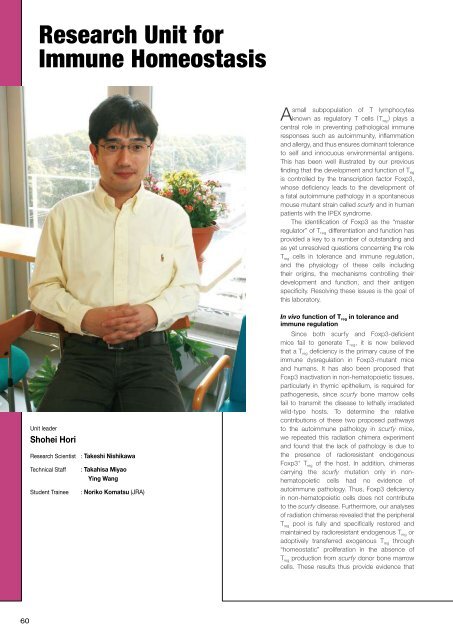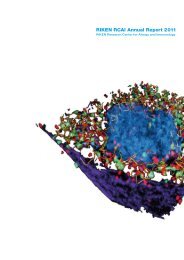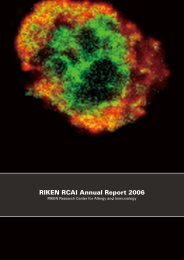in vivo
in vivo
in vivo
Create successful ePaper yourself
Turn your PDF publications into a flip-book with our unique Google optimized e-Paper software.
Research Unit for<br />
Immune Homeostasis<br />
small subpopulation of T lymphocytes<br />
A known as regulatory T cells (T reg<br />
) plays a<br />
central role <strong>in</strong> prevent<strong>in</strong>g pathological immune<br />
responses such as autoimmunity, <strong>in</strong>flammation<br />
and allergy, and thus ensures dom<strong>in</strong>ant tolerance<br />
to self and <strong>in</strong>nocuous environmental antigens.<br />
This has been well illustrated by our previous<br />
f<strong>in</strong>d<strong>in</strong>g that the development and function of T reg<br />
is controlled by the transcription factor Foxp3,<br />
whose deficiency leads to the development of<br />
a fatal autoimmune pathology <strong>in</strong> a spontaneous<br />
mouse mutant stra<strong>in</strong> called scurfy and <strong>in</strong> human<br />
patients with the IPEX syndrome.<br />
The identification of Foxp3 as the “master<br />
regulator” of T reg differentiation and function has<br />
provided a key to a number of outstand<strong>in</strong>g and<br />
as yet unresolved questions concern<strong>in</strong>g the role<br />
T reg cells <strong>in</strong> tolerance and immune regulation,<br />
and the physiology of these cells <strong>in</strong>clud<strong>in</strong>g<br />
their orig<strong>in</strong>s, the mechanisms controll<strong>in</strong>g their<br />
development and function, and their antigen<br />
specificity. Resolv<strong>in</strong>g these issues is the goal of<br />
this laboratory.<br />
Unit leader<br />
Shohei Hori<br />
Research Scientist : Takeshi Nishikawa<br />
Technical Staff<br />
Student Tra<strong>in</strong>ee<br />
: Takahisa Miyao<br />
Y<strong>in</strong>g Wang<br />
: Noriko Komatsu (JRA)<br />
In <strong>vivo</strong> function of T reg <strong>in</strong> tolerance and<br />
immune regulation<br />
S<strong>in</strong>ce both scurfy and Foxp3-deficient<br />
mice fail to generate T reg , it is now believed<br />
that a T reg deficiency is the primary cause of the<br />
immune dysregulation <strong>in</strong> Foxp3-mutant mice<br />
and humans. It has also been proposed that<br />
Foxp3 <strong>in</strong>activation <strong>in</strong> non-hematopoietic tissues,<br />
particularly <strong>in</strong> thymic epithelium, is required for<br />
pathogenesis, s<strong>in</strong>ce scurfy bone marrow cells<br />
fail to transmit the disease to lethally irradiated<br />
wild-type hosts. To determ<strong>in</strong>e the relative<br />
contributions of these two proposed pathways<br />
to the autoimmune pathology <strong>in</strong> scurfy mice,<br />
we repeated this radiation chimera experiment<br />
and found that the lack of pathology is due to<br />
the presence of radioresistant endogenous<br />
Foxp3 + T reg of the host. In addition, chimeras<br />
carry<strong>in</strong>g the scurfy mutation only <strong>in</strong> nonhematopoietic<br />
cells had no evidence of<br />
autoimmune pathology. Thus, Foxp3 deficiency<br />
<strong>in</strong> non-hematopoietic cells does not contribute<br />
to the scurfy disease. Furthermore, our analyses<br />
of radiation chimeras revealed that the peripheral<br />
T reg pool is fully and specifically restored and<br />
ma<strong>in</strong>ta<strong>in</strong>ed by radioresistant endogenous T reg or<br />
adoptively transferred exogenous T reg through<br />
“homeostatic” proliferation <strong>in</strong> the absence of<br />
T reg production from scurfy donor bone marrow<br />
cells. These results thus provide evidence that<br />
60





